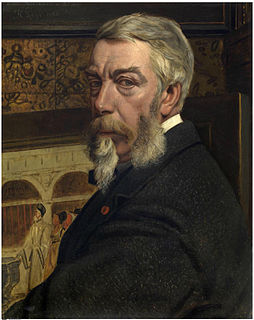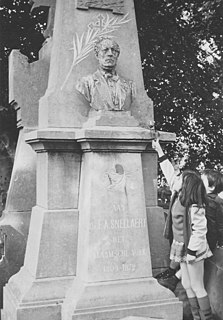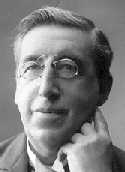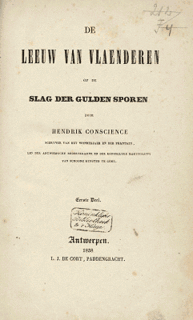This article includes a list of references, related reading or external links, but its sources remain unclear because it lacks inline citations .(January 2019) (Learn how and when to remove this template message) |

Pieter Frans van Kerckhoven (Antwerp, 10 November 1818 – Antwerp, 1 August 1857) was a Flemish writer and one of the leaders of the early Flemish movement. He was the son of a broker, and his well-off birth allowed him a decent education. After he had first been instructed in a private school, he passed through the Antwerp athenaeum together with his contemporary and friend Domien Sleeckx. Van Kerckhoven was in that period a tireless reader and spent almost his entire pocket money to buy books of the French traditional authors. During his youth, Van Kerckhoven was, just like the rest of its family, very religious. After Van Kerckhoven in 1836, graduated from the Antwerp athenaeum, he studied medicine in Italy, at the University of Bologna. In Italy, Van Kerckhoven witnessed the restless and rebellious Risorgimento. The confrontation with the liberal and anticlerical Risorgimento movement would determine his later progressive-liberal conviction. Van Kerckhoven evolved from a pious catholic to an enthusiastic and persuaded liberal. In spite of the personal change which Van Kerckhoven underwent in Italy, he remained, however, religious.

Antwerp is a city in Belgium, and is the capital of Antwerp province in Flanders. With a population of 520,504, it is the most populous city proper in Belgium, and with 1,200,000 the second largest metropolitan region after Brussels.
The Flemish or Flemings are a Germanic ethnic group native to Flanders, in modern Belgium, who speak Flemish, but mostly use the Dutch written language. They are one of two principal ethnic groups in Belgium, the other being the French-speaking Walloons. Flemish people make up the majority of the Belgian population. Historically, all inhabitants of the medieval County of Flanders were referred to as "Flemings", irrespective of the language spoken. The contemporary region of Flanders comprises a part of this historical county, as well as parts of the medieval duchy of Brabant and the medieval county of Loon.

Italy, officially the Italian Republic, is a European country consisting of a peninsula delimited by the Italian Alps and surrounded by several islands. Located in the middle of the Mediterranean sea and traversed along its length by the Apennines, Italy has a largely temperate seasonal climate. The country covers an area of 301,340 km2 (116,350 sq mi) and shares open land borders with France, Slovenia, Austria, Switzerland and the enclaved microstates of Vatican City and San Marino. Italy has a territorial exclave in Switzerland (Campione) and a maritime exclave in the Tunisian sea (Lampedusa). With around 60 million inhabitants, Italy is the fourth-most populous member state of the European Union.
Contents
Van Kerckhoven obtained the degree of baccalaurean in medicine and philosophy, but in June 1838 he suddenly returned to Antwerp, without finishing his studies. It is commonly believed that in Bologna it became too warm under the feet of Van Kerckhoven, after compromising contacts with the clandestine Carbonari movement. In Antwerp he would continue his medical studies at the Elisabeth hospital, but he would give them up quite rapidly. During that training he got acquainted, as it happens, with the students Jan De Laet and Hendrik Conscience, who almost immediately recognized his artistic talent and introduced him to the romantic artist group of the city. Already rapidly Van Kerckhoven would turn out to be himself one the central characters of the Antwerp cultural scene. Beside his office career (first in the business of his father and later at the city administration) he was now very active as an artist, literature critic and as head editor of several illustrated magazines, among which the Noordstar and the Vlaemsche Rederyker. Van Kerckhoven was also a member of literary societes of a private character, such as De Hermans, Het Heilig Verbond en De Olijftak. As a novelist he was not as popular as Hendrik Conscience, but nevertheless he was quite successful as an author and enjoyed as a lot of appreciation as a literature critic.

Bologna is the capital and largest city of the Emilia-Romagna Region in Northern Italy. It is the seventh most populous city in Italy, at the heart of a metropolitan area of about one million people.

The Carbonari was an informal network of secret revolutionary societies active in Italy from about 1800 to 1831. The Italian Carbonari may have further influenced other revolutionary groups in France, Greece, Spain, Portugal, Russia, Brazil and Uruguay. Although their goals often had a patriotic and liberal basis, they lacked a clear immediate political agenda. They were a focus for those unhappy with the repressive political situation in Italy following 1815, especially in the south of the Italian Peninsula. Members of the Carbonari, and those influenced by them, took part in important events in the process of Italian unification, especially the failed Revolution of 1820, and in the further development of Italian nationalism. The chief purpose was to defeat tyranny and to establish constitutional government. In the north of Italy other groups, such as the Adelfia and the Filadelfia, were associate organizations.

Henri (Hendrik) Conscience was a Belgian author. He is considered the pioneer of Dutch-language literature in Flanders, writing at a time when Belgium was dominated by the French language among the upper classes, in literature and government. Conscience fought as a Belgian revolutionary in 1830 and was a notable writer in the Romanticist style popular in the early 19th century. He is best known for his romantic nationalist novel, The Lion of Flanders (1838), inspired by the victory of a Flemish peasant militia over French knights at the 1302 Battle of the Golden Spurs during the Franco-Flemish War.
Reciprocal envy and Van Kerckhovens strive to make the Flemish movement more liberal, led as from 1846 to a split with Hendrik Conscience, who saw more in the alignment of the Flemish movement to the catholic politicians. The conflict escalated fast and it became, in 1847, a bitter feud which was fought out in the Antwerp magazines De Roskam en De Schrobber. In the leaflet De Vlaemsche Beweging (1847), aimed against Conscience and his allies, Van Kerckhoven displayed his brio as a polemist.
In these years it went well for Van Kerckhoven as he became a city clerk and published with Ziel en lichaem (1848) and the novel Liefde (1851) the pinnacle of his literary oeuvre. Moreover, he tirelessly contributes to the Vlaemsche Rederyker, a literature-critical illustrated magazine, of which he had been head editor since 1847. In 1852, Van Kerckhoven was even raised to knight in the Leopold order. however at the beginning of 1857 he became seriously ill. He appeared to suffer from tuberculosis and died some months later, aged 38.

Tuberculosis (TB) is an infectious disease usually caused by Mycobacterium tuberculosis (MTB) bacteria. Tuberculosis generally affects the lungs, but can also affect other parts of the body. Most infections do not have symptoms, in which case it is known as latent tuberculosis. About 10% of latent infections progress to active disease which, if left untreated, kills about half of those affected. The classic symptoms of active TB are a chronic cough with blood-containing sputum, fever, night sweats, and weight loss. It was historically called "consumption" due to the weight loss. Infection of other organs can cause a wide range of symptoms.















